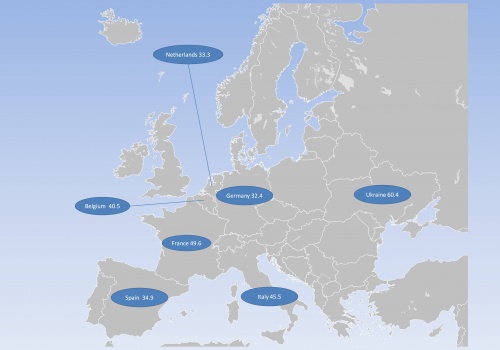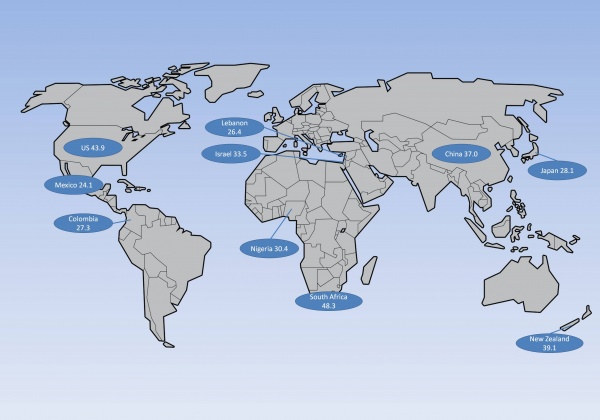Epidemiology of Pain: Difference between revisions
No edit summary |
No edit summary |
||
| Line 36: | Line 36: | ||
There is still debate as to whether this sex difference is due to the underlying biological mechanisms of pain or the contribution of psychological and social factors<ref name="Unruh 1996" />. | There is still debate as to whether this sex difference is due to the underlying biological mechanisms of pain or the contribution of psychological and social factors<ref name="Unruh 1996" />. | ||
=== Age === | === Age === | ||
There is not a clear relationship between age and onset of pain conditions, but, generally speaking, there is a higher prevalence of chronic pain in older age. | There is not a clear relationship between age and onset of pain conditions<ref name="Dionne 2006">Dionne CE, Dunn KM, Croft PR. Does back pain prevalence really decrease with increasing age? A systematic review. Age Ageing. 2006 Jan 5;35(3):229–34.</ref><ref name="Thomas 2007">Thomas E, Mottram S, Peat G, Wilkie R, Croft P. The effect of age on the onset of pain interference in a general population of older adults: Prospective findings from the North Staffordshire Osteoarthritis Project (NorStOP). Pain. 2007 May;129(1–2):21–7.</ref>, but, generally speaking, there is a higher prevalence of chronic pain in older age<ref name="Elliot 1999">Elliott AM, Smith BH, Penny KI, Cairns Smith W, Alastair Chambers W. The epidemiology of chronic pain in the community. The Lancet. 1999 Oct 9;354(9186):1248–52.</ref>. Regarding this, recent studies have found that pain remains a prevalent and serious problem in older age, demonstrated by the following data: the prevalence of chronic pain in older people (>65 years) living in the community ranges from 25.0% to 76.0%, while the prevalence of chronic pain in older people living in residential care is much higher and ranges from 83.0% to 93.0%<ref name="Abdulla 2013">Abdulla A, Adams N, Bone M, Elliott AM, Gaffin J, Jones D, et al. Guidance on the management of pain in older people. Age Ageing. 2013 Mar;42 Suppl 1:i1-57.</ref>. | ||
Given that the world's population aged | |||
Given that the world's population aged >65 is likely to double in the next 40 years, treatment needs to take cognisance of pain-related co-morbidities and polypharmacy. | |||
== References<br> == | == References<br> == | ||
Revision as of 13:26, 29 April 2016
- Please do not edit unless you are involved in this project, but please come back in the near future to check out new information!!
- If you would like to get involved in this project and earn accreditation for your contributions, please get in touch!
Tips for writing this page:
- Describe current evidence for pain epidemiology, acute and chronic.
- Describe the public health implications of this epidemiological picture including refernce to social, ethical, and economic considerations
Original Editor - Alberto Bertaggia.
Top Contributors - Alberto Bertaggia, Jo Etherton, Kim Jackson, 127.0.0.1, Rachael Lowe, WikiSysop, Amanda Ager, Lauren Lopez and Jess Bell
Introduction[edit | edit source]
As of today, it is difficult to define the epidemiology of pain because of its subjective nature of the symptoms and the lack of consensus for specific diagnoses and conditions, therefore it is hard to talk about evidences for the true incidence of most pain conditions[1].
People can experience pain as an acute acute, chronic, or intermittent condition, or a combination of the three[2]. Specifically, chronic pain is a complex condition embracing physical, social and psychological factors, consequently leading to disability, loss of independence and poor quality of life (QoL)[3]. It seems clear there is the need for Public Health to address pain as a disease itself[4][5], rather than a simple symptom, in order to provide better interventions for the management and the prevention of pain[6].
Epidemiology[edit | edit source]
As stated above, there is a lack of evidences for the incidence of pain[1]. Despite this, a world-scale epidemiolgy report of 2008 produced by Tsang et al. shows an age-standardized prevalence of chronic pain conditions in the previous 12 months of 37.3% in developed countries and 41.1% in developing countries, with an overall prevalence of 38.4%[7]. The pictures belows shows the crude prevalence of any pain condition in previous 12 months (%) among various countries[7].
A 2006 study state that approximately 20% of the adult European population were having chronic pain with fewer than 2% of sufferers ever attend a pain clinic and one-third of the chronic pain sufferers were currently not being treated[3].
Furthermore, it has been estimated that 1 in 5 adults suffer from pain and that another 1 in 10 adults are diagnosed with chronic pain each year globally[8]
Socio-demographic factors associated with chronic pain
[edit | edit source]
Gender[edit | edit source]
Adult female individuals show a higher preponderance for chronic pain, associated with lower pain thersholds and tolerance[9]. Furthermore, pain episodes are more frequent and of longer duration in women than men[10][11]. However, the greatest gender differences are seen in the prevalence of chronic pain syndromes[12].
There is still debate as to whether this sex difference is due to the underlying biological mechanisms of pain or the contribution of psychological and social factors[11].
Age[edit | edit source]
There is not a clear relationship between age and onset of pain conditions[13][14], but, generally speaking, there is a higher prevalence of chronic pain in older age[15]. Regarding this, recent studies have found that pain remains a prevalent and serious problem in older age, demonstrated by the following data: the prevalence of chronic pain in older people (>65 years) living in the community ranges from 25.0% to 76.0%, while the prevalence of chronic pain in older people living in residential care is much higher and ranges from 83.0% to 93.0%[16].
Given that the world's population aged >65 is likely to double in the next 40 years, treatment needs to take cognisance of pain-related co-morbidities and polypharmacy.
References
[edit | edit source]
- ↑ 1.0 1.1 Henschke N, Kamper SJ, Maher CG. The epidemiology and economic consequences of pain. Mayo Clin Proc. 2015 Jan;90(1):139–47.
- ↑ Goldberg DS, McGee SJ. Pain as a global public health priority. BMC Public Health. 2011;11:770.
- ↑ 3.0 3.1 Breivik H, Collett B, Ventafridda V, Cohen R, Gallacher D. Survey of chronic pain in Europe: prevalence, impact on daily life, and treatment. Eur J Pain. 2006 May;10(4):287–333.
- ↑ McGee SJ, Kaylor BD, Emmott H, Christopher MJ. Defining chronic pain ethics. Pain Med. 2011 Sep;12(9):1376–84.
- ↑ Tracey I, Bushnell MC. How Neuroimaging Studies Have Challenged Us to Rethink: Is Chronic Pain a Disease? The Journal of Pain. 2009 Nov;10(11):1113–20.
- ↑ Hecke O van, Torrance N, Smith BH. Chronic pain epidemiology and its clinical relevance. Br J Anaesth. 2013 Jan 7;111(1):13–8.
- ↑ 7.0 7.1 Tsang A, Von Korff M, Lee S, Alonso J, Karam E, Angermeyer MC, et al. Common chronic pain conditions in developed and developing countries: gender and age differences and comorbidity with depression-anxiety disorders. J Pain. 2008 Oct;9(10):883–91.
- ↑ International Association for the Study of Pain: Unrelieved pain is a major global healthcare problem. available at: http://www.iasp-pain.org/files/Content/ContentFolders/GlobalYearAgainstPain2/20042005RighttoPainRelief/factsheet.pdf
- ↑ Wiesenfeld-Hallin Z. Sex differences in pain perception. Gender Medicine. 2005 Sep;2(3):137–45.
- ↑ Macfarlane TV, Glenny A-M, Worthington HV. Systematic review of population-based epidemiological studies of oro-facial pain. Journal of Dentistry. 2001 Sep 1;29(7):451–67.
- ↑ 11.0 11.1 Unruh AM. Gender variations in clinical pain experience. Pain. 1996 Jun;65(2–3):123–67.
- ↑ Greenspan JD, Craft RM, LeResche L, Arendt-Nielsen L, Berkley KJ, Fillingim RB, et al. Studying sex and gender differences in pain and analgesia: A consensus report. PAIN. 2007 Nov;132, Supplement 1:S26–45.
- ↑ Dionne CE, Dunn KM, Croft PR. Does back pain prevalence really decrease with increasing age? A systematic review. Age Ageing. 2006 Jan 5;35(3):229–34.
- ↑ Thomas E, Mottram S, Peat G, Wilkie R, Croft P. The effect of age on the onset of pain interference in a general population of older adults: Prospective findings from the North Staffordshire Osteoarthritis Project (NorStOP). Pain. 2007 May;129(1–2):21–7.
- ↑ Elliott AM, Smith BH, Penny KI, Cairns Smith W, Alastair Chambers W. The epidemiology of chronic pain in the community. The Lancet. 1999 Oct 9;354(9186):1248–52.
- ↑ Abdulla A, Adams N, Bone M, Elliott AM, Gaffin J, Jones D, et al. Guidance on the management of pain in older people. Age Ageing. 2013 Mar;42 Suppl 1:i1-57.








